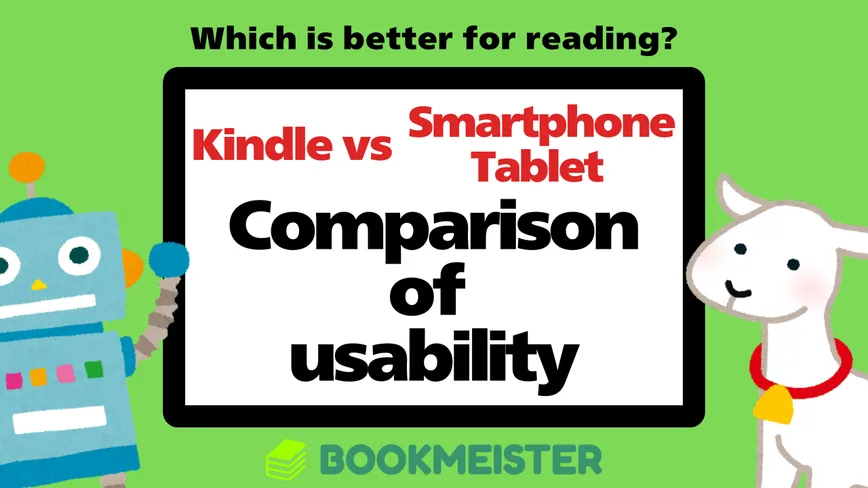
Do You Really Need a Kindle? Smartphone & Tablet vs Kindle Usability Compared
Are Expensive, Book-Only Devices Really Worth It? An eBook Reader with 10+ Years Experience Compares Kindle vs Smartphones & Tablets
Modified at: 2025.9.4Posted at: 2024.5.27
Comparing the Reading Experience: Kindle Devices, Smartphones, and Tablets
First, let’s compare the reading experience across Kindle devices, smartphones, and tablets. From here, the unique features of Kindle devices become clear.
| Feature | Kindle Device | Smartphone | Tablet |
|---|---|---|---|
| Display | E-ink technology that is gentle on the eyes (very little blue light) | LCD display (includes blue light) | LCD display (includes blue light) |
| Battery Life | Lasts several weeks | About 1 day (shorter with heavy app usage) | About 1–2 days (shorter with heavy app usage) |
| Reading Only | Yes | No (multitasking possible) | No (multitasking possible) |
| Weight & Portability | Lightweight (around 150–200g) | Very lightweight (around 100–200g) | Heavier (around 300–600g) |
| Eye Strain | Minimal | Blue light causes more strain | Blue light causes more strain |
| Price | Higher upfront cost | No extra cost if already owned | No extra cost if already owned |
| Book Management | Kindle Library | Kindle app or other apps | Kindle app or other apps |
| Other Uses | Reading only | Phone calls, messaging, apps, etc. | Apps, video streaming, browsing, etc. |
| Waterproofing | Available on some models | None | Available on some models |
| Storage Capacity | Typically 8GB–32GB | 16GB–512GB+ expandable with microSD on some models | 16GB–1TB+ expandable with microSD on some models |
Benefits of Using a Kindle Device
From the comparison above, the main benefits of a Kindle device are:
- Easy-to-read, eye-friendly screen
- Long-lasting battery life
- Lightweight, even with larger screens
At first glance, this list may not seem impressive. However, once you actually use a Kindle, you’ll find these three points are exactly the reasons why it’s worth choosing a dedicated Kindle over other devices.
Since you hold the device in your hands the entire time while reading, light weight is absolutely essential. In addition, if you want to be able to “read whenever you feel like it,” long battery life becomes a crucial factor.
Another thing you really notice when actually using a Kindle device is the readability of the E-Ink display. Smartphone and tablet screens use a backlight that shines from behind the display, whereas Kindle devices use a front light that illuminates the E-Ink screen from the front, which makes a big difference in reducing eye strain.
Personally, I’ve used smartphones, iPads, Kindles, and Kobo devices, but in the end, I settled on the Kindle. I still use my iPad for magazines and other media, but when it comes to reading books, my go-to device is the Kindle (specifically the Kindle Oasis).
Benefits of Reading on Smartphones and Tablets
On the other hand, if we focus specifically on reading, the main advantages of using a smartphone or tablet are:
- You can use the device you already carry every day
- The ability to expand storage
The biggest advantage here is expandable storage. With Android smartphones and tablets, you can add storage at low cost using a microSD card—up to around 512GB. With 512GB, you can store over 5,000 comic book volumes, making it possible to keep your entire eBook collection on the device itself and essentially use it as a “portable library.” This is a strong advantage of smartphones and tablets.
By contrast, Kindle devices typically come with only about 8GB of storage, with the maximum being 64GB, and they don’t allow microSD expansion.
That said, with Kindle, your eBooks are stored on Amazon’s cloud servers. By downloading them as needed, you can work around the limited onboard storage to a certain degree.
Even for self-scanned eBooks, you can use the Send to Kindle feature to save them as personal documents, enabling you to wirelessly access and read them on your Kindle whenever you want.
When You Don’t Really Need a Kindle Device
So far, we’ve looked at the benefits of Kindle devices for reading. However, there are also cases where a Kindle may not be necessary.
Those cases are when:
- Your main reading is through manga apps
- You mostly read during commutes on trains or buses
- You don’t read for long periods or very often
Since Kindle devices cannot install third-party apps, manga apps are not available. For people who primarily enjoy reading through manga apps, a Kindle is simply not suitable.
If you like to read during your commute, a smartphone is typically the best choice. No matter how lightweight the Kindle may be, nothing beats the convenience of quickly pulling out your phone and reading one-handed in a crowded train. Factoring in the hassle of taking the Kindle out of your bag, it’s not as practical in this situation.
Finally, if your reading time is short or infrequent, it makes more sense financially to use the device you already own and spend your money on books themselves, rather than investing in a separate Kindle device.